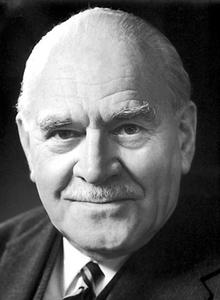Ronald George Wreyford Norrish
Ronald George Wreyford Norrish | |
|---|---|
 | |
| Born | 9 November 1897 |
| Died | 7 June 1978 (aged 80) |
| Nationality | United Kingdom |
| Alma mater | University of Cambridge (BA, PhD) |
| Known for | Norrish reaction |
| Awards |
|
| Scientific career | |
| Fields | Chemistry |
| Institutions | University of Cambridge |
| Thesis | Radiation and chemical reactivity (1924) |
| Doctoral advisor | Eric Rideal[1] |
Ronald George Wreyford Norrish FRS[1] (9 November 1897 – 7 June 1978) was a British chemist who was awarded the Nobel Prize in Chemistry in 1967.[2][3][4]
Education and early life
Norrish was born in Cambridge and was educated at The Perse School and Emmanuel College, Cambridge.[5] He was a former student of Eric Rideal.[1]
Career and research
Norrish was a prisoner in World War I and later commented, with sadness, that many of his contemporaries and potential competitors at Cambridge had not survived the War.
Norrish rejoined Emmanuel College as a Research Fellow in 1925 and later became the Head of the Physical Chemistry Department at the University of Cambridge, occupying part of the Lensfield Road Building with the separate department 'Chemistry' (which encompassed organic, theoretical and inorganic chemistry). Both departments had separate administrative, technical and academic personnel until they merged to form one chemistry department under John Meurig Thomas in the early 1980s. Norrish researched photochemistry using continuous light sources (including after the war, searchlights).
Awards and honours
Norrish was elected a Fellow of the Royal Society (FRS) in 1936.[1] As a result of the development of flash photolysis, Norrish was awarded the Nobel Prize in Chemistry in 1967 along with Manfred Eigen and George Porter[6] for their study of extremely fast chemical reactions.[5] One of his accomplishments is the development of the Norrish reaction.
At Cambridge, Norrish supervised Rosalind Franklin, future DNA researcher and colleague of James Watson and Francis Crick, and experienced some conflict with her.[7]
References
- ^ a b c d e Dainton, F.; Thrush, B. A. (1981). "Ronald George Wreyford Norrish. 9 November 1897-7 June 1978". Biographical Memoirs of Fellows of the Royal Society. 27 (0): 379–424. doi:10.1098/rsbm.1981.0016. ISSN 0080-4606.
- ^ Norrish's Nobel Foundation biography
- ^ Norrish's Nobel Lecture Some Fast Reactions in Gases Studied by Flash Photolysis and Kinetic Spectroscopy
- ^ Ronald George Wreyford Norrish publications indexed by Microsoft Academic
- ^ a b "Ronald George Wreyford Norrish (1897 – 1978)". Emmanuel College, Cambridge. Retrieved January 25, 2012.
- ^ Fleming, G. R.; Phillips, D. (2004). "George Porter KT OM, Lord Porter of Luddenham. 6 December 1920 - 31 August 2002: Elected F.R.S. 1960". Biographical Memoirs of Fellows of the Royal Society. 50 (0): 257–283. doi:10.1098/rsbm.2004.0017. ISSN 0080-4606.
- ^ Rosalind Franklin: The Dark Lady of DNA. New York: HarperCollins, 2002. ISBN 0-06-018407-8, p. 72
- 1897 births
- 1978 deaths
- People from Cambridge
- People educated at The Perse School
- Alumni of Emmanuel College, Cambridge
- Fellows of Emmanuel College, Cambridge
- Nobel laureates in Chemistry
- British Nobel laureates
- English physical chemists
- World War I prisoners of war held by Germany
- Faraday Lecturers
- Fellows of the Royal Society
- English Nobel laureates
- British World War I prisoners of war

